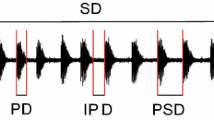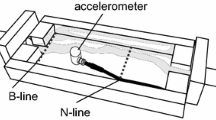Abstract
An important question in stingless bee communication is whether the thorax vibrations produced by foragers of the genus Melipona upon their return to the nest contain spatial information about food sources or not. As previously shown M. seminigra is able to use visual flow to estimate flight distances. The present study investigated whether foraging bees encode the visually measured distance in their thorax vibrations. Bees were trained to collect food in flight tunnels lined with a black-and-white pattern on their side walls and floor, which substantially influenced the image motion they experienced. When the bees had collected inside the tunnels the temporal pattern of their vibrations differed significantly from the pattern after collecting in a natural environment. These changes, however, were not associated with the visual flow experienced inside the tunnel. Bees collecting in tunnels offering little visual flow (stripes parallel to flight direction) modified their vibrations similarly to bees collecting in tunnels with high image motion (cross stripes). A higher energy expenditure due to drastically reduced flight velocities inside the tunnel is suggested to be responsible for changes in the thorax vibrations. The bees’ vibrations would thus reflect the overall energetic budget of a foraging trip.








Similar content being viewed by others
Notes
São João, Açucar cristal superior: 99.8% sucrose, 0.1% glucose/fructose, 0.1% mineral salts
References
Aguilar I, Briceño D (2002) Sounds in Melipona costaricensis (Apidae: Meliponini): effect of sugar concentration and nectar source distance. Apidologie 33:375–388
Chenlo F, Moreira R, Pereira G (2002) Osmotic dehydration: viscosity of solutions of sucrose and sodium chloride. Actas del 2o Congresso Español de Ingeniería de Alimentos. University of Lleida, Spain
Dyer FC (2002) The biology of the dance language. Annu Rev Entomol 47:917–49
Esch H (1967) Die Bedeutung der Lauterzeugung für die Verständigung bei den stachellosen Bienen. Z Vergl Physiol 56:43–53
Esch HE, Burns JE (1995) Honeybees use optic flow to measure the distance of a food source. Naturwissenschaften 82:38–40
Esch HE, Burns JE (1996) Distance estimation by foraging honeybees. J Exp Biol 199:155–162
Esch HE, Wilson D (1967) The sounds produced by flies and bees. Z Vergl Physiol 54:256–267
Esch H, Esch I, Kerr WE (1965) Sound: an element common to communication of stingless bees and to dances of honey bees. Science 149:320–321
Esch HE, Zhang SW, Srinivasan MV, Tautz J (2001) Honeybee dances communicate distances measured by optic flow. Nature 411:581–583
Frisch K von (1965) Tanzsprache und Orientierung der Bienen. Springer, Berlin Heidelberg New York
Hanauer-Thieser U, Nachtigall W (1995) Flight of the honey bee. VI. energetics of wind tunnel exhaustion flights at defined fuel content, speed adaptation and aerodynamics. J Comp Physiol B 165:471–483
Hrncir M (2003) Properties and significance of recruitment signals in a stingless bee (Melipona seminigra Friese 1903). PhD thesis, University of Vienna, Austria
Hrncir M, Jarau S, Zucchi R, Barth FG (2000) Recruitment behavior in stingless bees, Melipona scutellaris and Melipona quadrifasciata. II. Possible mechanisms of communication. Apidologie 31:93–113
Hrncir M, Zucchi R, Barth FG (2002) Mechanical recruitment signals in Melipona vary with gains and costs at the food source. Anais do V Encontro Sobre Abelhas, Ribeirão Preto, Brasil, pp 172–175
Hrncir M, Jarau S, Zucchi R, Barth FG (2003) A stingless bee (Melipona seminigra) uses optic flow to estimate flight distances. J Comp Physiol A 189:761–768
Hrncir M, Jarau S, Zucchi R, Barth FG (2004) Thorax vibrations of a stingless bee (Melipona seminigra). II. Dependence on sugar concentration (in press)
Jarau S, Hrncir M, Zucchi R, Barth FG (2000) Recruitment behavior in stingless bees, Melipona scutellaris and Melipona quadrifasciata. I. Foraging at food sources differing in direction and distance. Apidologie 31:81–91
Jarau S, Hrncir M, Schmidt VM, Zucchi R, Barth FG (2003) Effectiveness of recruitment behavior in stingless bees (Apidae, Meliponini). Insectes Soc 50:365–374
Kerr WE, Ferreira A, Mattos NS (1963) Communication among stingless bees—additional data (Hymenoptera: Apidae). J N Y Entomol Soc 71:80–90
Lindauer M, Kerr WE (1958) Die gegenseitige Verständigung bei den stachellosen Bienen. Z Vergl Physiol 41:405–434
Nachtigall W, Rothe U, Feller P, Jungmann R (1989) Flight of the honey bee. III. Flight metabolic power calculated from gas analysis, thermoregulation and fuel consumption. J Comp Physiol B 158:729–737
Nachtigall W, Hanauer-Thieser U, Mörz M (1995) Flight of the honey bee. VII. metabolic power versus flight speed relation. J Comp Physiol B 165:484–489
Nieh JC, Roubik DW (1995) A stingless bee (Melipona panamica) indicates food location without using a scent trail. Behav Ecol Sociobiol 37:63–70
Nieh JC, Roubik DW (1998) Potential mechanisms for the communication of height and distance by a stingless bee, Melipona panamica. Behav Ecol Sociobiol 43:387–399
Nieh JC, Contrera FAL, Rangel J, Imperatriz-Fonseca VL (2003) Effect of food location and quality on recruitment sounds and success in two stingless bees, Melipona mandacaia and Melipona bicolor. Behav Ecol Sociobiol 55:87–94
Schmidt VM, Zucchi R, Barth FG (2003) A stingless bee marks the feeding site in addition to the scent path (Scaptotrigona aff. depilis Moure 1942). Apidologie 34:237–248
Seeley TD (1995) The wisdom of the hive. Harvard University Press, Cambridge
Sokal RR, Rohlf FJ (1995) Biometry, 3rd edn. Freeman, New York
Srinivasan MV, Zhang SW, Lehrer M, Collett TS (1996) Honeybee navigation en route to the goal: visual flight control and odometry. J Exp Biol 199:237–244
Srinivasan MV, Zhang SW, Bidwell NJ (1997) Visually mediated odometry in honeybees. J Exp Biol 200:2531–2522
Srinivasan MV, Zhang SW, Altwein M, Tautz J (2000) Honeybee navigation: nature and calibration of the “odometer”. Science 287:851–853
Weast RC, Lide DR, Astle MJ, Beyer WH (eds) (1989) CRC handbook of chemistry and physics, 70th edn. CRC Press, Boca Raton, Florida
Acknowledgements
We would like to thank Sidnei Mateus for his patience and an omnipresent helping hand. This work complies with the current laws of Brazil where the experiments were carried out. It was supported by grant P14328 of the Austrian Science Foundation (FWF) to F.G.B.
Author information
Authors and Affiliations
Corresponding author
Rights and permissions
About this article
Cite this article
Hrncir, M., Jarau, S., Zucchi, R. et al. Thorax vibrations of a stingless bee (Melipona seminigra). I. No influence of visual flow. J Comp Physiol A 190, 539–548 (2004). https://doi.org/10.1007/s00359-004-0514-7
Received:
Revised:
Accepted:
Published:
Issue Date:
DOI: https://doi.org/10.1007/s00359-004-0514-7




